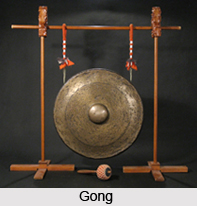 The Gong is a slightly convex, round metal disk which is hit with a mallet. It originated in South East Asia, in particular China. It is a percussion sonorous or musical instrument of Chinese origin and manufacture, made in the form of a broad thin disk with a deep rim that has spread to Southeast Asia - a type of flat bell. It gradually found its way to Western Europe not only as an ornament to decorate the walls of well-to-do citizens, but also as an instrument in Western music. The Western gong may alternatively be called a tamtam.
The Gong is a slightly convex, round metal disk which is hit with a mallet. It originated in South East Asia, in particular China. It is a percussion sonorous or musical instrument of Chinese origin and manufacture, made in the form of a broad thin disk with a deep rim that has spread to Southeast Asia - a type of flat bell. It gradually found its way to Western Europe not only as an ornament to decorate the walls of well-to-do citizens, but also as an instrument in Western music. The Western gong may alternatively be called a tamtam.
The gong is usually made of brass, copper, or bronze, suspended by a cord attached at two points to the wide rim. The pitch depends on the size and weight of the gong. Gongs are to be found with diameters ranging from 8-28 inches. Broadly speaking, gongs are of three types- suspended gongs, bossed gongs and bowl gangs. Suspended gongs are more or less flat, circular discs of metal suspended vertically by means of a cord passed through holes near to the top rim. Bossed gongs have a raised center boss and are often suspended and played horizontally. Bowl gongs are bowl-shaped, and rest on cushions and belong more to bells than gongs.
The gong is beaten at the centre with a round, hard, leather-covered pad, fitted on a short stick or handle. The stick may or may not be cloth tipped. It emits a peculiarly sonorous sound, its complex vibrations bursting into a wave-like succession of tones, sometimes shrill, sometimes deep. Where required, the tone is dampened with the hand. Gongs can also be immersed into a tub of water after being struck. This is called "water gong" and is called for in several orchestral pieces. In China and Japan it is used in religious ceremonies, state processions, marriages and other festivals; and it is said that the Chinese can modify its tone variously by particular ways of striking the disk. In the Western world, the gong has been effectively used in the orchestra to intensify the impression of fear and horror in melodramatic scenes.
The Indian gong is a circular, brass instrument used for the purposes of percussion in music. Most often, the gong is used for religious processions and music concerts in India. It is hung by a metal wire through a hole near the edge of circumference. It is vibrated by a metal (iron) hammer after repeated intervals to get sound of same pitch.




















